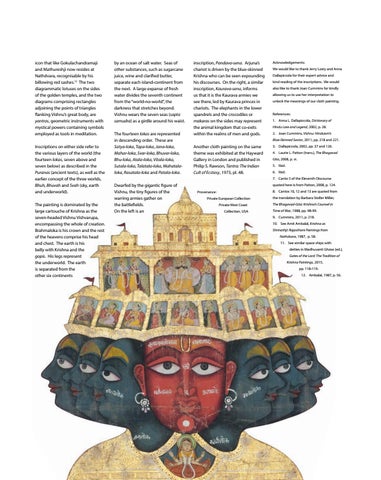icon that like Gokulachandramaji and Mathureshji now resides at Nathdvara, recognisable by his billowing red sashes.12 The two diagrammatic lotuses on the sides of the golden temples, and the two diagrams comprising rectangles adjoining the points of triangles flanking Vishnu’s great body, are yantras, geometric instruments with mystical powers containing symbols employed as tools in meditation. Inscriptions on either side refer to the various layers of the world (the fourteen lokas, seven above and seven below) as described in the Puranas (ancient texts), as well as the earlier concept of the three worlds, Bhuh, Bhuvah and Svah (sky, earth and underworld). The painting is dominated by the large cartouche of Krishna as the seven-headed Vishnu Vishvarupa, encompassing the whole of creation. Brahmaloka is his crown and the rest of the heavens comprise his head and chest. The earth is his belly with Krishna and the gopis. His legs represent the underworld. The earth is separated from the other six continents
by an ocean of salt water. Seas of other substances, such as sugarcane juice, wine and clarified butter, separate each island-continent from the next. A large expanse of fresh water divides the seventh continent from the “world-no-world”, the darkness that stretches beyond. Vishnu wears the seven seas (sapta samudra) as a girdle around his waist. The fourteen lokas are represented in descending order. These are Satya-loka, Tapa-loka, Jana-loka, Mahar-loka, Svar-loka, Bhuvar-loka, Bhu-loka, Atala-loka, Vitala-loka, Sutala-loka, Talatala-loka, Mahatalaloka, Rasatala-loka and Patala-loka.
inscription, Pandava-sena. Arjuna’s chariot is driven by the blue-skinned Krishna who can be seen expounding his discourses. On the right, a similar inscription, Kaurava-sena, informs us that it is the Kaurava armies we see there, led by Kaurava princes in chariots. The elephants in the lower spandrels and the crocodiles or makaras on the sides may represent the animal kingdom that co-exits within the realms of men and gods.
Acknowledgements: We would like to thank Jerry Losty and Anna Dallapiccola for their expert advice and kind reading of the inscriptions. We would also like to thank Joan Cummins for kindly allowing us to use her interpretation to unlock the meanings of our cloth painting. References: 1. Anna L. Dallapiccola, Dictionary of Hindu Lore and Legend, 2002, p. 28. 2. Joan Cummins, Vishnu: Hinduism’s Blue-Skinned Savior, 2011, pp. 218 and 221.
Another cloth painting on the same theme was exhibited at the Hayward Gallery in London and published in Philip S. Rawson, Tantra: The Indian Cult of Ecstasy, 1973, pl. 48.
3. Dallapiccola, 2002, pp. 37 and 126. 4. Laurie L. Patton (trans.), The Bhagavad Gita, 2008, p. vi. 5. Ibid. 6. Ibid. 7. Canto 5 of the Eleventh Discourse
Dwarfed by the gigantic figure of Vishnu, the tiny figures of the warring armies gather on the battlefields. On the left is an
quoted here is from Patton, 2008, p. 124. 8. Cantos 10, 12 and 13 are quoted from
Provenance: Private European Collection Private West Coast Collection, USA
the translation by Barbara Stoller Miller, The Bhagavad-Gita: Krishna’s Counsel in Time of War, 1988, pp. 98-99. 9. Cummins, 2011, p. 218. 10. See Amit Ambalal, Krishna as Shrinathji: Rajasthani Paintings from Nathdvara, 1987, p. 58. 11. See similar space ships with deities in Madhuvanti Ghose (ed.), Gates of the Lord: The Tradition of Krishna Paintings, 2015, pp. 118-119. 12. Ambalal, 1987, p. 56.
